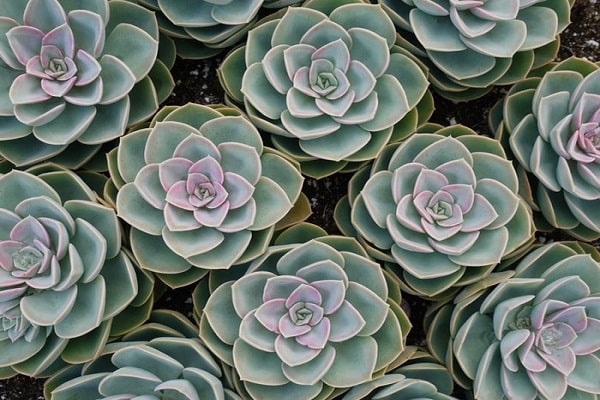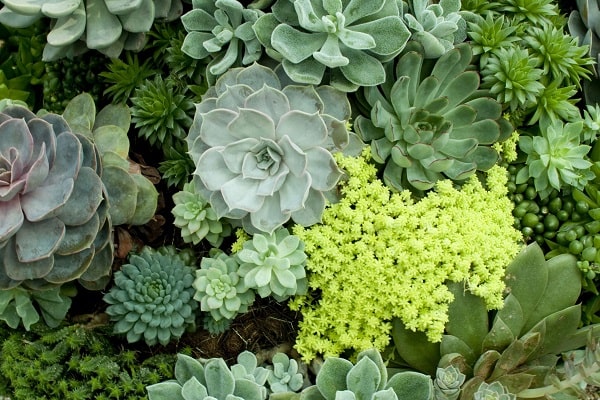Succulents are plants that store water in their leaves, stems, or roots. Succulent plants are the perfect choice for gardeners who want to add a little something extra to their landscapes without having to water them often. They also make great additions to tree gardens because they help keep trees hydrated and provide habitat for wildlife.
Can you plant succulents under a tree? Yes, in a nutshell, but with some restrictions. Succulents like to live in dry and nutrient-rich soil, so they may not do well in the moisture-retentive environment of a tree canopy. Additionally, succulents can get covered in leaves and twigs, leading to shading and decreased water uptake.
I’ll go over the best succulent planting methods under trees in this article, along with some maintenance tips. Follow along to discover more!
Quick Navigation
The Best Way To Plant Succulents Under A Tree

Suppose you are looking for a low-maintenance landscape option that will add an element of natural beauty to your home. In that case, a succulent may be a perfect choice. Succulents come in all sorts of shapes and sizes. They can be planted in various locations, from inside to outside the home.
When planting succulents under trees, it is important to consider their growth habits and water needs. For example, some trees need more water and may not do well with succulents planted close to their trunk or roots. It’s also crucial to consider the type of succulents you are planting. Some can thrive in shaded areas, while others need full sunlight.
Planting succulents under trees is a great way to add beauty and functionality to your landscaping without having to handle heavy maintenance tasks. Follow these tips to plant succulents successfully under a tree:
Choose The Right Succulent
When choosing a succulent to plant under a tree, it is important to consider the type of soil and climate the succulent will be in. Some succulents commonly grown under trees include Ficus, Jade, and Sempervivum. Each of these plants requires different conditions to thrive. For example, Jade plants prefer moist soil but do well in areas with low humidity; Ficus trees require indirect sunlight to thrive but are adaptable to a wide range of climates, and Sempervivum needs well-drained soil with full sun or light shade.
Choose The Right Size
Choosing the right size of succulents for planting under a tree is important. Most succulents grow rapidly into tall shrubs or trees, so choose one that will fit under your tree’s canopy and not overpower it.
Prepare Your Planting Area
Succulents like well-drained soil, so ensure the area you’re planting them in is well-prepared. Before planting your succulent under a tree, ensure the ground is prepared properly by adding organic matter (such as compost) and adjusting the pH level if necessary. Succulents like moist soil but do not require constant watering like other plants; however, you should keep them watered if they reside in areas with low humidity or are in direct sunlight.
Plant The Succulent
Place the succulent in the ground after loosening the soil around it with a fork. Be sure to water the succulent regularly under the tree; once it has grown, you might only need to water it once every other week.
Protect Your Succulents
Although succulents are tough plants, accidents happen. If your succulent falls below the ground, protect it by covering it with a layer of mulch or soil.
Enjoy Your Succulent
Now that your succulent is planted and growing, enjoy its beautiful blooms and lush foliage! Succulents are perfect additions to any garden and can be easy to care for if you follow these tips.
Succulent Plant Varieties That Can You Plant Succulents Under A Tree

Because they have a long lifespan and can thrive in various soils and climates, succulents are a fantastic choice for planting under trees. A few different varieties of succulents can be grown beneath a tree:
- Aloes: Aloes are a popular succulent because they can grow a long stem and produce beautiful flowers. Aloes need full sunlight to grow well, so they are unsuitable under trees in shady areas.
- Crassulas: Crassulas are another type of succulents that can tolerate shade and can be grown in various soils. They produce jagged, pointy leaves and small, pink or white flowers.
- Epiphyllums: Epiphyllums are popular for their large, lacy leaves that can grow up to 18 inches long. They grow attractive flowers like other succulents and can endure various climates, including zones 9 to 11.
- Ficus: Ficus is a versatile tree-succulent hybrid commonly used as an indoor plant. Ficus requires indirect sunlight to thrive but is adaptable to various climates and soils.
- Jade: Jade plants are popular for their bright green leaves and delicate flowers lasting up to two months in bloom. They prefer moist soil but do well in areas with low humidity and zones 9-11.
- Sempervivum: Sempervivum is a succulent plant that grows best in full sun or light shade environments and does not require watering often if kept moist. It produces clusters of small, purple flowers on long stems and prefers well-drained soil.
- Nepeta cataria: Nepeta cataria is the most commonly grown succulent under trees. This easy-to-care-for plant grows quickly into a tall shrub or tree form, reaching heights of 12 feet or more. It favors moist, well-drained soil and either full sun or light shade.
Maintenance Tips For Succulents Under Trees

When planting succulents under trees, it is important to consider the plant’s specific needs. For example, some succulents do better with more acidic soil, while others need water. Additionally, many succulents need direct sunlight and cannot grow in shaded areas. Here are some maintenance tips for succulents under trees:
- Check the soil pH regularly: Succulents need slightly acidic soil (5.5-6 on the pH scale), so it’s important to check the pH level regularly and correct any necessary problems. Overpumping or overwatering can cause your succulent to become leggy or stunted and its leaves to turn brown or die.
- Water sparingly: Don’t water your succulents too much; give it a light watering every few days during dry periods and only when the soil is completely dry. Over-watering can cause your plant to wilt, its leaves to curl up, and its roots to rot.
- Provide good drainage: Succulent plants like plenty of airflow around their roots, so ensure good drainage in your planting area. When watering, water deeply and allow the soil to dry before watering again.
- Prop up your succulent: A succulent not supported will eventually fall over due to its weight. To prop up a succulent, use chopsticks or a piece of wire bent into a U-shape and inserted into the soil at a 45-degree angle away from the plant’s base.
- Fertilize your succulents: Succulent plants need little to no fertilizer. If you do fertilize, use a low-nitrogen fertilizer specifically for succulents.
- Prune your succulents: After the new growth has stopped, late winter or early spring are the best times to prune succulents. Trim the plant’s base away from the soil with a sharp pair of shears or a gardening snipping tool to create a bushy mound.
Frequently Asked Questions
Where Is The Best Place To Plant Succulents?
Succulents are a great choice for planting in areas that receive a lot of sunlight, as they need only a small amount of light to grow. They also do well in areas with good air circulation. Some popular succulent plants include aloe vera, echeveria, sedum, and cactus.
Can Succulents Do Ok In The Shade?
Succulents can do OK in the shade. However, they may not do as well in direct sunlight because this can cause them to become sunburned and scorched. Shade also helps to keep these plants cool in summer and helps to protect them from heavy rain or snowfall.
Can Succulents Live Without Sun?
Plants that can grow without direct sunlight are known as succulents. Through photosynthesis, they have evolved to capture solar energy indirectly. Succulents may not require as much sunshine as other plants, and they can still develop beautifully and healthily without it.
How Many Hours Of The Sun Do Succulents Need?
In order to grow the best, succulents require at least 8 hours of sunlight per day. Accordingly, they should be placed in regions that receive at least eight hours of direct sunlight.
Do Succulents Like To Be Crowded?
Succulents, such as cacti do not like to be crowded. They need plenty of light and air to prosper. If succulents are too crowded, they may become unhealthy and die.
In Closing
Succulents can be planted beneath trees successfully if the right conditions are met. Make sure to follow the plant’s specific requirements for growth in this environment, and be prepared to give your succulents a lot of attention – they don’t like being ignored! Finally, remind yourself that succulents are living plants, so be sure to water them regularly and check for pests.

My name is Md Deloar Hossain and I’m the creator of Club Gardening, designed for all your gardening ideas, gardening product reviews, and a place to help you find the best gardening experience possible.


